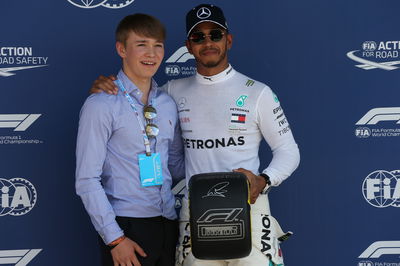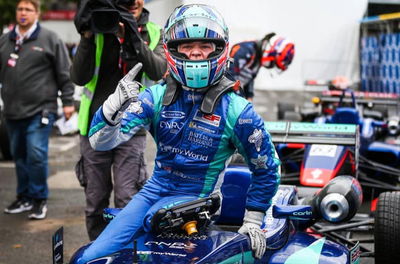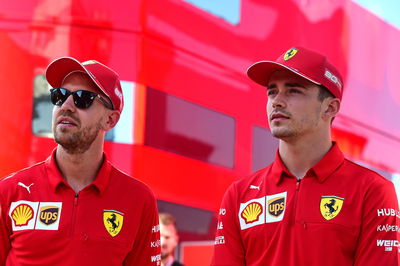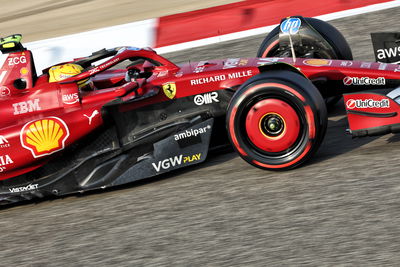How Monger wants to be known for racing and not his accident
Billy Monger’s story of his harrowing accident and inspiring comeback is one well told over the past two years and will, by his own admission, always shape his life. But it isn’t the story he wants to tell now.
At just 20, Monger has achieved more than many of us will in a lifetime and his trophy collection continues to grow thanks to his exploits both on and off track.

Billy Monger’s story of his harrowing accident and inspiring comeback is one well told over the past two years and will, by his own admission, always shape his life. But it isn’t the story he wants to tell now.
At just 20, Monger has achieved more than many of us will in a lifetime and his trophy collection continues to grow thanks to his exploits both on and off track.
His latest accolade, the Segrave Trophy awarded by the Royal Automobile Club for “those with the spirit of adventure for the most outstanding demonstration of transportation by land, sea or water,” sees him join a prestigious list of winners including Lewis Hamilton, Sir Stirling Moss and Joey Dunlop.
Monger becomes the youngest recipient of the award following his stunning fightback from a double leg amputation suffered in a horrific Formula 4 crash at Donington Park in April 2017 and currently competes in the Euroformula Open Championship – recently winning at the iconic Pau Grand Prix.
In a whirlwind two years, Monger knows his life will never be the same even if a sense of normality has returned. But after being the boy who lost his legs and raced again, he wants the next part of his life to begin: Billy Monger the racing driver.
“I am a racing driver and I am not just some guy who has had an accident and gone back to racing because that is what he enjoys,” Monger said. “I have gone back to racing because in the bigger picture I would like to be in Formula 1.
“I think it would be pretty cool if I could be world champion considering what has happened to me. That’s still the goal.”
Monger’s story is one which only tells itself but should also sell itself, and despite his success on track it turns out the Charlwood-born driver hasn’t had backers knocking on his door to help. Quite the opposite.
Weighing up his ambition of joining the FIA Formula 3 grid, which runs as a support class to Formula 1 following a racing pathway restructuring, racing budget remains one of the biggest hurdles even for one of the most famous drivers competing outside of the glamorous F1 bubble.
“Before my accident I had to fund my racing through finding sponsors myself so I am use to it,” he explained. “Obviously at that point I was 15 or 16, knocking on business’s doors going ‘I am a racing driver, a British champion and I want to be in Formula 1, will you give me an amount so I represent your brand’.
“It is weird because a lot of people don’t realise, I would struggle for budget. There are moments with the people I work with sit there and think what have we got to do to make people realise that if Billy doesn’t get sponsorship he won’t be racing.
“Maybe if I wasn’t in the car for a season because I didn’t get the sponsorship then people might realise I’m not just saying it for the sake of it. It is a real problem.”

One of Monger’s biggest backers is Carlin, the popular British team from Farnham founded and run by Trevor Carlin, and the team Patrik Pasma was racing for when Monger hit the Finn in his life-changing accident at Donington Park.
Monger pours credit on Carlin for helping him not only return to racing but maintain his dream by working with him to manufacturer adapted car controls which he uses to race.
“Carlin can’t be left out as they are the ones who make it happen,” he said. “As much as it is a joint-effort I don’t manufacturer any of these parts myself, I am not too good hands-on, and I wouldn’t trust myself building my own car.
“So it comes through them but both of us are involved in the ideas to make it work. I’ve done two years with the system I am using now and there are still parts of me that think maybe I should try things differently. A bigger throttle paddle or a throttle higher or lower on the steering wheel.”
As the level gets tougher, so does Monger’s challenge as a pioneer for disabled racing.
While the FIA have been supporters to his ambition, Monger has been working with the governing body to find the limits in unchartered territory.
Monger currently uses a finger-operated throttle lever attached to the back of his steering wheel and a prosthetic leg on a brake pedal which, unsurprisingly, is a first at a Formula 3-specification level which led to the FIA altering its own rules to allow Monger to race.
“Motorsport is all about gaining as much of an advantage as you can and the FIA are there to make sure I don’t gain an advantage over my competitors,” he said. “That’s their involvement, to make sure I am not gaining any advantage by using the throttle hand lever or braking with the prosthetic.
“For me it is obvious I am not gaining any advantage, but I need to maximise what I am allowed to do by the FIA with my controls. I need to be the one hunting an advantage for the FIA to bring me back and tell me if I am gaining an advantage which is not right. At the minute I don’t think I am at that level.
“I have got the controls that work for me and there are still situations in the wet doing the clutch off the start I have struggled with. In certain conditions or riding over kerbs trying to be smoother on my throttle hand control.
“There are still areas when I come in, see the data, and see there is nothing I could have done there to improve my input, it is more about how I can operate the car that needs to improve so it can replicate the inputs that I need.
“There is more work to be done in that area and nobody is going to push that one on apart from me so there is a lot of responsibility.”
Speaking to Monger his maturity comes across beyond his age, a trait his family says he had before his accident, and having a wise head on young shoulders makes an inspiring impression – something each recipient of the Segrave Trophy holds without mention – but the guidance of Alex Zanardi proved invaluable going through his toughest moments.
Zanardi, a former F1 driver with 41 race starts to his name, lost both his legs in a horrendous accident in a crash competing at the Lausitzring in CART in 2001 which ended his single-seater racing career.
But just under two years on, Zanardi returned to racing in the FIA World Touring Car Championship with support from BMW, also using adapted car controls, before going on to win multiple Paralympic and World Championship gold medals in hand cycling.
“When I was in hospital going through my accident and going through a very similar situation to what Alex had been through it was so relatable and that it made me feel at ease with my situation,” he said.
“When I spoke to Alex after my accident, he knew I was a racing driver and he knew I would like to get things done as quickly as possible. He told me to take a bit of time, don’t try to rush yourself back into anything.
“He gave me the advice that this is the process to mainly get me to walk again. He said this is a process and how you handle it will affect the rest of your life. If you try to rush through it and cut corners in how you learn to walk, you will walk that way for the rest of your life.
“Make sure you do everything exactly the right way so that once you learn it and the muscle memory is there you don’t have to go back and relearn it because you are doing it wrong or messing it up.
“As a racing driver you want to do everything as quickly as possible but with this take your time, do it right and then you will reap the benefits from it forever.”
Monger’s burning ambition to race at the highest level and reach Formula 1 is still a realistic goal albeit with a number of challenges no other driver he competes against will have to face.
But with plenty of years ahead of him combined with the profile and inner belief unblighted by his accident, Monger’s story has only just begun.











